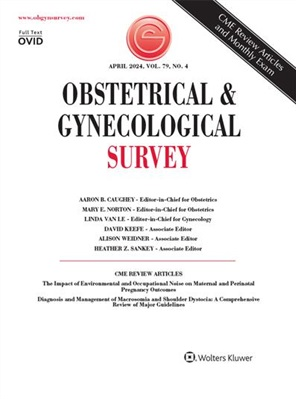ChatGPT在妇产科的激动人心的潜力
IF 3.6
4区 医学
Q1 OBSTETRICS & GYNECOLOGY
引用次数: 0
摘要
2022年11月,人工智能实验室OpenAI推出了在线聊天机器人ChatGPT(聊天生成预训练转换器),这是一种可访问的语言模型,它使用自然语言处理(NLP)的人工智能(AI)分支来回答基于“互联网,书籍和其他来源”的1750亿个参数库的提示。由于ChatGPT能够用简单易懂的英语回答临床问题,提供者和患者都能理解,因此ChatGPT作为临床工具的潜力是显而易见的。尽管这些数据的来源知识丰富,但可能存在偏见和不可靠,可能无法反映当前的立场。此外,ChatGPT没有列出其信息来源,其目前正确回答临床问题的能力尚不清楚。本研究旨在评估ChatGPT对一系列关于妇产科的问题的回答,包括系统级问题、伦理问题和与治疗相关的决策。总共问了14个问题。第一个问题是为什么美国的早产率如此之高。第二个问题要求医生列出最重要的干预措施,以监测、预防和治疗早产。第三个问题是阴道黄体酮对于预防中期短宫颈的妇女早产是否有效和安全,第四个问题是同样的问题,但对于有早产史但没有短宫颈的妇女。第五个问题是为什么美国的产妇死亡率如此之高。第六个问题是产科医生可以做些什么来预防先兆子痫。第七个问题是关于在美国将医院分娩与计划在家分娩进行比较的安全性。第八个问题是产科医生在没有得到妇女知情同意的情况下为挽救胎儿或母亲而提供紧急剖宫产在道德上是否可以接受。第九个问题是产科医生应如何筛查怀孕期间的家庭暴力和亲密伴侣暴力。第10个问题是女性是否应该冷冻卵子,以及在什么年龄冷冻。第11个问题是关于更年期激素替代疗法的风险和益处。第12个问题问及美国的堕胎禁令如何影响妇女的健康和生活。第13个问题是复杂增生异型手术是否只能由妇科肿瘤科医生进行。最后一个问题是,我们是否应该继续使用“孕妇”这个词,而不是包括“孕妇”在内的替代词。总的来说,ChatGPT提供了细致入微和知情的答案,几乎任何话题的产科和妇科的问题,但偶尔暴露出明显缺乏洞察力的问题被问到。ChatGPT可以提供关于广泛主题的初步信息,对提供者和患者都很有价值,并且随着训练数据的更新和模型从用户提示中学习,ChatGPT将继续改进。本文章由计算机程序翻译,如有差异,请以英文原文为准。
The Exciting Potential for ChatGPT in Obstetrics and Gynecology
ABSTRACT In November 2022, AI Lab OpenAI launched the online chatbot ChatGPT (Chat Generative Pre-Trained Transformer), an accessible language model that uses the artificial intelligence (AI) branch of natural language processing (NLP) to answer prompts based on a library of 175 billion parameters from the “internet, books and other sources.” Because of its ability to answer clinical questions in plain English that can be understood by providers and patients alike, the potential for ChatGPT to be used as a clinical tool is obvious. Despite its impressive fund of source knowledge, these data are potentially biased and unreliable and may not reflect current stances. In addition, ChatGPT does not list sources for its information, and its current capability to answer clinical questions correctly is not well understood. This study aimed to assess answers given by ChatGPT in response to a spectrum of questions about obstetrics and gynecology including systems-level questions, ethical questions, and treatment-related decision making. A total of 14 questions were asked. The first question asked why US preterm birth rates are so high. The second question asked for a list of the most important interventions physicians can do to monitor, prevent, and treat premature births. The third question asked whether vaginal progesterone was effective and safe for preventing preterm birth in women with a short cervix in the midtrimester, and the fourth question asked the same question but in women with a history of preterm birth and no short cervix. The fifth question asked why maternal mortality rates in the United States are so high. The sixth question asked for a list of what obstetricians can do to prevent preeclampsia. The seventh question asked about the safety of hospital births when compared with planned home births in the United States. The eighth question asked whether it is ethically acceptable for an obstetrician to provide emergency cesarean delivery without a woman's informed consent to save the fetus or the mother. The ninth question asked how obstetricians should screen for domestic abuse and intimate partner violence in pregnancy. The 10th question asked if women should freeze their eggs and at what age. The 11th question asked about the risks and benefits of menopause hormone replacement therapy. The 12th question asked how abortion bans in the United States affect women's health and lives. The 13th question asked whether complex hyperplasia atypia surgery should be performed only by a gynecologist-oncologist. The final question asked whether we should continue using the term “pregnant woman” versus alternative including “pregnant person.” Overall, ChatGPT provided nuanced and informed answers to question on virtually any topic in obstetrics and gynecology, but occasionally revealed an apparent lack of insight into the questions being asked. ChatGPT can provide preliminary information about a wide range of topics and can be valuable to both providers and patients and will continue to improve as training data are updated, and the model learns from user prompts.
求助全文
通过发布文献求助,成功后即可免费获取论文全文。
去求助
来源期刊
CiteScore
2.70
自引率
3.20%
发文量
245
审稿时长
>12 weeks
期刊介绍:
Each monthly issue of Obstetrical & Gynecological Survey presents summaries of the most timely and clinically relevant research being published worldwide. These concise, easy-to-read summaries provide expert insight into how to apply the latest research to patient care. The accompanying editorial commentary puts the studies into perspective and supplies authoritative guidance. The result is a valuable, time-saving resource for busy clinicians.

 求助内容:
求助内容: 应助结果提醒方式:
应助结果提醒方式:


